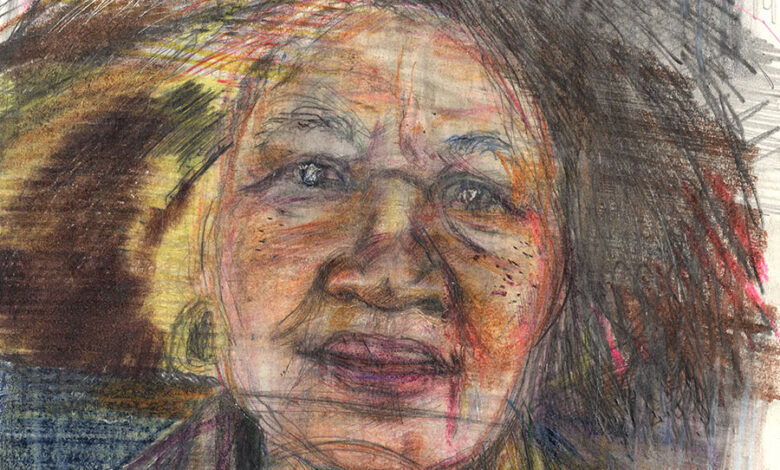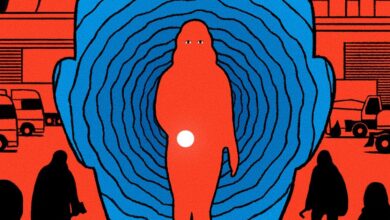Suddenly, Jamaica | Henry Louis Gates Jr.

“Girl,” Jamaica Kincaid’s first published short story, appeared in June 1978 in The New Yorker, a magazine I could find time for only during summer vacation, when I would lie in my parents’ backyard and read each issue straight through—or, at least, I would try to. I seem to have stumbled on “Girl” without glancing at its author’s name. I had just submitted my doctoral thesis at Cambridge and was anxiously awaiting word of its approval, which would allow me to become an assistant professor of English and Afro-American studies at Yale. Exhausted by the ordeal, I found leafing through those splendid pages to be welcome relief. I knew that in the magazine’s weekly short story I would find style and literary titillation; I wasn’t expecting to find work that exploded my sense of what fiction could achieve.
At Cambridge neither African nor African American literature was a part of the English curriculum; I don’t think it occurred to anyone that either ever would be. It was understood that we wouldn’t write dissertations about living writers, let alone those who were black. Wole Soyinka, the future Nobel Prize laureate from Nigeria, had been denied a visiting appointment in the department the year I arrived, ostensibly because African literature was not English literature.1 The undergraduate curriculum focused on the practical criticism of English and American poetry and the history of tragedy, beginning with the Greeks.
I had been assigned to teach a class on the Afro-American novel. During college, at Yale, in this category I had read only Richard Wright’s Native Son (1940), Ralph Ellison’s Invisible Man (1952), and Jean Toomer’s Cane (1923), so I was essentially starting from scratch.2 I began my reading with Toni Morrison’s The Bluest Eye (1970) and Sula (1973), then moved on to James Alan McPherson’s Hue and Cry (1968), Ishmael Reed’s wildly original satire Mumbo Jumbo (1972), Leon Forrest’s There Is a Tree More Ancient Than Eden (1973), Charles Johnson’s Faith and the Good Thing (1974), Gayl Jones’s shape-shifting Corregidora (1975), David Bradley’s South Street (1975), and Reed’s parody of the slave narrative genre, Flight to Canada (1976). Novice though I was, I could see from this self-imposed syllabus that African American literature was in the midst of something of a Renascence, a burst of vigorous creativity from a younger generation of writers.
Each was, it seemed to me, intentionally and rather self-consciously extending Ellison’s tradition of literary modernism. In his twist on the bildungsroman, Ellison had his nameless protagonist write himself into being, describing how he sheds the identities that have been forced upon him. This was distinct from Wright’s more strident naturalism. Unlike Ellison, Wright used third-person narration to present static protagonists who were doomed from birth by the unyielding, totalizing forces of racism and capitalism. In Wright’s work, black politics play out through literary form: aesthetic value is inextricably tied to theme, to message. Perhaps it is not surprising that practitioners of black aesthetic critical theory, especially Addison Gayle, championed Wright’s work at the expense of Ellison’s. (Ellison never forgave the insult. His best friend, Albert Murray, coined the phrase “the social science fiction monster” in part to describe the naturalism of authors like Wright.)
Having come of age in the Sixties, I witnessed Martin Luther King Jr.’s movement to end segregation yield to the separatist politics of Stokely Carmichael’s Black Power Movement. By the early Seventies, Black Power and the corresponding Black Arts Movement (associated especially with writers like Amiri Baraka) had peaked. Baraka and his cohort expressed great resentment toward Ellison, whose “invisible” protagonist winds up living in a hole; they saw him as the embodiment of the antirevolutionary, in contrast to Wright and his visceral action man (who, we must remember, accidentally murders a white girl, then cuts off her head and sets her corpse ablaze).3
In my graduate school years I saw a new body of work by African American writers—especially black women like Morrison and Alice Walker—emerging. These writers were concerned as much with form, aesthetic quality, and self-expression as they were with “themes” like black liberation or the fight against white racism. By the time I submitted my dissertation, a new generation of critics had begun the search for a language worthy of this dramatically new literature.
I will never forget a conversation I had around this time with the venerable scholar Eleanor Traylor—a close friend of Morrison, Maya Angelou, and James Baldwin who would later become the chair of the Department of English at Howard. She remarked to me that it was time for black writers to “assume their propositions, and stop feeling the need to claim them.” By this she meant that they should make the fact of their “blackness” the default and write about what it means to be a human being who also happens to be black—or not! Black writers should stop feeling the need to plead our people’s case, she said, or to refute centuries of racist dogma about our supposed “natures,” and get on with making literature. This struck me straightaway with enormous force. Yes, leave the revolution-making to politicians and activists.
It was with her charge in my subconscious that, not a year later, I discovered “Girl”:
This is how to make a good medicine for a cold; this is how to make a good medicine to throw away a child before it even becomes a child; this is how to catch a fish; this is how to throw back a fish you don’t like, and that way something bad won’t fall on you; this is how to bully a man; this is how a man bullies you; this is how to love a man, and if this doesn’t work there are other ways, and if they don’t work don’t feel too bad about giving up; this is how to spit up in the air if you feel like it, and this is how to move quick so that it doesn’t fall on you; this is how to make ends meet; always squeeze bread to make sure it’s fresh; but what if the baker won’t let me feel the bread?; you mean to say that after all you are really going to be the kind of woman who the baker won’t let near the bread?
It would be difficult for me to exaggerate my astonishment at this story. This was a long way from Native Son, to be sure. Was the author black? Could this author be black? She had, with great determination, refused to say what she was. There were clues, certainly, but very subtle ones, such as dishes like pumpkin fritters and food like salt fish, and something that one sings called “benna,” but her reader could learn the meaning of that only by looking it up. This author was not pandering to a white reader or, for that matter, to a non-Caribbean one. The world she had created was self-contained.
Only the author’s first name, Jamaica, surely a nom de plume, convinced me that she could be a black woman. For a brief moment, I have to confess, I wondered whether she was a white woman who was trying to put us off the trail. Nobody could actually be named Jamaica.
Jamaica’s penchant for assuming the blackness of her characters without saying so, in the same way that white writers assume the whiteness of their characters without saying so, seems to me to have been a major departure from the history of African American literature. (This approach characterizes Soyinka’s work, too; the characters in his plays are primarily Yoruba, their world Nigeria.)
The three “fathers” of African American literature in the postwar period—Richard Wright, James Baldwin, and Ralph Ellison—broke through the US market’s race barriers in the productive years following World War II, long after the Harlem Renaissance had become the stuff of literary history. For each of them “blackness” was the great subject; Negro literature was necessarily defined as literature about Negroes written by Negroes. (And mostly by and about Negro men, though Gwendolyn Brooks’s Maud Martha, a protofeminist novel, was shamefully undervalued when it was published in 1953. It was later resurrected by black feminist critics, starting with Mary Helen Washington in her pioneering anthology Black-Eyed Susans in 1975.)
On the very first page of Native Son, Wright tells us that “light flooded the room and revealed a black boy standing in a narrow space between two iron beds, rubbing his eyes with the backs of his hands.” (His memoir, of course, was called Black Boy.) Baldwin—Wright’s protégé, who went on to slay him at the crossroads of naturalism and modernism—conveyed the race of his characters in the first pages of his first novel, Go Tell It on the Mountain (1953), writing of the congregants at his evangelical Temple of the Fire Baptized:
a round, black man named Deacon Braithwaite…a genial, well-fed man with a face like a darker moon…. [John] watched the black skin glisten while they lifted up their arms and fell on their faces before the Lord.
Meanwhile the very conceit of Ellison’s Invisible Man is the failure to tell one’s own story.
Granted, Wright, Baldwin, and Ellison had little choice but to depict the blackness of their characters explicitly. Many of their books were written during Jim Crow segregation, the nadir in American race relations. Considering what was politically demanded of black literature during the desperate struggle against antiblack racism under Jim Crow, maybe it is not surprising that, in works by black writers from the period, a character’s blackness is clearly marked. Take a look at Jamaica’s more immediate literary antecedent, Morrison, whose Song of Solomon was published in 1977. In that novel Morrison uses the word “black” to describe her characters about forty times.
In November 1983 The New Yorker published Jamaica’s “The Circling Hand,” certainly one of my favorite short stories in English literature, in which the practice of assuming propositions is on magnificent display. (Later it was published as a chapter of Annie John.) Its subject is the onset of adulthood and the incursion of the adult realm of desire into the pure world of childhood, which breaks the intense bond the child, Annie John, a fictionalized version of Jamaica herself, has until then had with her mother. The story opens with a memory of her and her mother taking a bath together. Later, arriving home early from school one afternoon, she witnesses a scene of intimacy between her mother and father, and for the first time she becomes a stranger to her mother and herself:
When I got to our house, I rushed into the yard and called out to her, but no answer came. I then walked into the house. At first, I didn’t hear anything. Then I heard sounds coming from the direction of my parents’ room. My mother must be in there, I thought. When I got to the door, I could see that my mother and father were lying in their bed. It didn’t interest me what they were doing—only that my mother’s hand was on the small of my father’s back and that it was making a circular motion. But her hand! It was white and bony, as if it had long been dead and had been left out in the elements. It seemed not to be her hand, and yet it could only be her hand, so well did I know it. It went around and around in the same circular motion, and I looked at it as if I would never see anything else in my life again. If I were to forget everything else in the world, I could not forget her hand as it looked then. I could also make out that the sounds I had heard were her kissing my father’s ears and his mouth and his face. I looked at them for I don’t know how long.
That same autumn of 1983, I was offered a chaired professorship in English at Cornell. In my own writing, I was beginning to piece together the formal relationship between Invisible Man and Mumbo Jumbo through a study of “signifying” in black vernacular. I was intrigued by how black writers riff on one another, like links in a chain of tradition—how they represent “blackness,” from whom and through whom. It was clear that black writers read and revised one another while often pretending that they had not, claiming paternity from white fathers, never black ones, like Ellison did to bypass Wright’s clear influence on him.
For Wright, all Negroes were black; Morrison, on the other hand, seemed intrigued by the range of browns that actually color our skins. (For all of Ellison’s unpopularity during my youth, many towering black writers who came after him—Morrison, Colson Whitehead, Jamaica herself—followed in the tradition of his modernism. Wright, who was loudly championed by Black Aesthetic critics in his lifetime, has fewer important descendants, though I would consider Sapphire and Kiese Laymon—as well as rap artists like NWA and Chief Keef—to be his heirs.)
I don’t think that any black writer before Jamaica had successfully foregrounded a very small episode in a character’s life in order to reveal the complex discovery of his or her humanity—a certain inevitable alienation between mother and daughter, in “The Circling Hand”—without in some way tying it to the much larger question of black–white race relations. Never before.
Revealing this emotion between mother and daughter is what “The Circling Hand” is about. It is not about a black mother and her black daughter on some island, difficult to pronounce correctly, floating somewhere in the Caribbean. It is about itself—an act of language, first and foremost. And that is both an astonishing fact and an astonishing achievement. “We must write less of issues that are particular and more of feelings that are general,” the free-born black poet Frances Ellen Watkins Harper pleaded in a letter to Thomas Hamilton, the august editor of The Anglo-African, in 1861. “We are blessed with hearts and brains that compass more than ourselves in our present plight.”
But suddenly came Jamaica: a striking voice, mordant, irreverent, unremitting, and generous. She blends reportage and personal experience with a deep understanding of history, showing how events out there can be felt in here. “Dear Mr. Crusoe, Please don’t come,” she wrote in an introduction to a new edition of Robinson Crusoe in 2019. She laughs at the things that are meant to frighten her. “Once,” she wrote in Rolling Stone in 1977,
as I was walking down a street and just about to pass by a man, he said to me, “Hey sugar, you coming at me like a fresh baked cake.” When I didn’t say anything but kept on walking he crept up behind me and whispered in my ear, “Speak Devil, speak.” I looked at him and I laughed out loud.
I wanted to read more, and so I did. I knew that I wanted to meet this writer, to speak to her about what she was up to. In the 1986–1987 academic year at Cornell, my colleagues and I invited her to give a reading. I remember that, as she emerged from my car for dinner, she was quite taken with our garden. When I moved down to Duke in 1989 I invited her again. And almost as soon as I was hired to rebuild the Department of Afro-American Studies at Harvard, hers was our first long-term appointment. Determined as I was to study and even celebrate great black writing, who else would I have turned to first?
I am proud to say that we have become friends. Shortly after I published my memoir, Colored People, in 1994, Jamaica invited me to give a joint reading at her place of worship, Congregation Beth El in Bennington, Vermont. And when my wife and I purchased our house in Cambridge nearly ten years ago, Jamaica insisted on designing our garden.
Gardens have become one of Jamaica’s major themes, along with race, racism, colonialism, and literature itself. I believe each of these themes could be subsumed in her work under the maternal—the biological, the colonial, and the social. Without question, her great subject is her mother, Annie Victoria Richardson. Annie gave birth to Jamaica in St. John’s, Antigua, on Wednesday, May 25, 1949. She named her Elaine Potter Richardson.
Jamaica learned that she was born out of wedlock when she realized, she wrote me recently in a letter, that “I was christened on a Thursday not a Sunday because I was an illegitimate child,” the English colonial practice. (“Monday’s child is fair of face,/Tuesday’s child is full of grace./Wednesday’s child is full of woe,/Thursday’s child has far to go,” as the English nursery rhyme goes.) Annie was thirty when her daughter was born, the first of four children. (Jamaica suspects that her mother was so old by Antiguan standards because she had “cleaned out her womb”—that is, had an abortion or several.)
Annie was born in Dominica. Jamaica’s father, Roderick Potter, was an Antiguan taxi driver and chauffeur whom she barely knew. Jamaica told me that she doesn’t know how her parents met; Annie never told her. “I do know,” she wrote me,
that when she was 7 months pregnant with me, she took money he was saving up to open his own business and left him. He seemed to have held me responsible for that and along with other reasons (Colonial Law, for one) his name does not appear on my birth certificate. The column where his name should be has a line in black ink drawn through it.
Jamaica was raised in St. John’s by her mother and the man who would eventually become her stepfather, David Drew, a cabinetmaker. Annie doted on Jamaica when she was a child, taught her to read, made her clothes, and ensured that she received an education. She became a leading character in her daughter’s work, from Annie John (1985) to Mr. Potter (2002). In Jamaica’s collected nonfiction, the word “mother” appears over three hundred times, the phrase “my mother” over two hundred times.
Jamaica’s relationship with her mother changed after the birth of her three brothers in 1958, 1960, and 1962. She wrote that her mother lost interest in her and instead spent her time caring for her sons and her ill husband, who was suffering from heart and digestive problems. Her resentment grew when she was removed from school, first to help out at home and then, in 1965, to move to the United States to work as an au pair in Scarsdale, New York. Her mother ordered her to send money home; Jamaica refused.
In My Brother (1997), the narrator’s mother burns all the books hidden around their house “in a fury” at her daughter for insisting on reading rather than helping her. We feel the powerful ambivalence that that relationship generates. “Then again,” Jamaica wrote in Harper’s in 2009, after saying that she was not thinking of her mother, “I am always thinking of my mother; I believe every action of a certain kind that I make is completely influenced by her, completely infused with her realness, her existence in my life.” And their estrangement—Jamaica didn’t see her mother for twenty years, until her daughter, whom she named Annie, was born—remains throughout her nonfiction the source of a deep and abiding grief. It is the major condition of her work; it is into that breach that she writes.
The force of Jamaica’s self-scrutiny spreads to her other themes, even outside to the garden. Following a New Yorker tradition created by Katharine White, the magazine’s first fiction editor and the wife of E.B. White, she wrote a regular column, In the Garden, for the magazine from 1992 to 1996. She published My Garden (Book) in 1991, Among Flowers in 2005, and last year, with Kara Walker, An Encyclopedia of Gardening for Colored Children.
The gardens she writes about are full of bright Hibiscus moscheutos and also danger under the feet. In My Brother, she writes of the red ants that, on her brother’s first day of life, climbed up an okra plant and through an open window into the house and attacked him. “It is no surprise to me,” she writes in “The Disturbances of the Garden” (2020),
that my affection for the garden, including its most disturbing attributes, its most violent implications and associations, is intertwined with my mother. As a child, I did not know myself or the world I inhabited without her. She is the person who gave me and taught me the Word.
Jamaica spelunks into the mud of racism, colonialism, and even global appropriation—shame is a lightning rod for her—but with a sublime intimacy, in a voice that calls her reader in without the self-important scaffolding that we find in Wright, Ellison, and Baldwin. One might say that her work is self-consciously modest, that her fiction never grandstands. It gets to the marrow of how motherhood, childhood, and femininity are dented by colonialism, certainly, but it does so by illuminating the struggle simply to become a human being. I think this is why Jamaica has never felt the need to mark her characters by race.
The irreverence (what can be more irreverent than quarreling so consistently in public with one’s mother?), humanity, vulnerability, and modesty of her offering amount to something quite special—something primarily literary and not primarily political. Her work isn’t even secondarily political, even when she writes about the most vexed of ministerial matters, such as the effects of colonialism on her native Caribbean. The urgency of the fight against racism, sexism, and colonialism never upstages the urgency to plumb the depths of being alive.
In The Souls of Black Folk W.E.B. Du Bois described a “double-consciousness,” an unnatural condition forced on the American Negro by “this sense of always looking at oneself through the eyes of others, of measuring one’s soul by the tape of a world that looks on in amused contempt and pity.” The metaphor has become one of the controlling notions in the African American literary tradition, from perhaps its first repetition in James Weldon Johnson’s Autobiography of an Ex-Coloured Man (1912) right through Morrison’s Beloved (1987). The cause of double-consciousness, of course, is an almost totalizing antiblack racism that “yields [the American Negro] no true self-consciousness, but only lets him see himself through the revelation of the other world.”
In “Biography of a Dress” (1992), Jamaica depicts an almost primal moment of separation—from herself, but through her mother, as her two-year-old self attempts to recover from the pain of having her ears pierced by “two thorns that had been heated in a fire.” Was that pain given by her mother intentional, a passing along of the pains of childbirth, perhaps? Or was that pain
meant to express hostility or aggression toward me (but without meaning to and without knowing that it was possible to mean to). For days afterward my earlobes were swollen and covered with a golden crust (which might have glistened in the harsh sunlight, but I can only imagine that now), and the pain of my earlobes must have filled up all that made up my entire being then and the pain of my earlobes must have been unbearable, because it was then that was the first time that I separated myself from myself, and I became two people (two small children then, I was two years old), one having the experience, the other observing the one having the experience.
This self-division and Jamaica’s consciousness of that division—because of her mother—is what gave her a voice, and ultimately what proved liberatory in her work.
Source link




